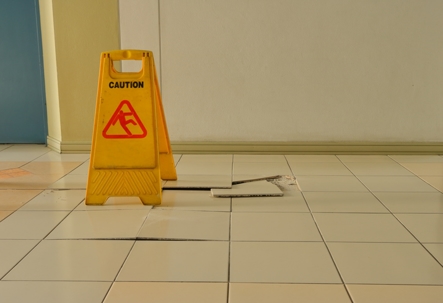Whether you’re slipping on a wet grocery store floor, tripping over uneven pavement, or getting hurt in another unsafe space, premises liability law is there to protect you. If you were injured on someone else’s property, you might have grounds to file a claim—but proving negligence is the key to winning your case.
Premises liability isn’t as simple as “you got hurt, so someone’s at fault.” To secure compensation, you'll need evidence to show the property owner or manager acted carelessly, and that carelessness led to your injuries.
What Is Premises Liability?
Premises liability refers to the legal responsibility property owners, managers, or occupiers have to maintain a safe environment for visitors. This applies to private homes, commercial properties like stores or restaurants, and public spaces like parks.
Examples of Premises Liability Accident Causes:
- Slippery floors (from spills)
- Broken stairs or handrails
- Poor lighting in walkways
- Hazardous debris left in public areas
- Falling objects (e.g., loose merchandise)
If a property owner fails to address hazards like these and someone gets hurt, they could be held liable under premises liability laws. However, proving liability requires one major ingredient—negligence.
What Is Negligence in Premises Liability Cases?
Negligence happens when someone doesn’t act with the care a reasonable person would under similar circumstances, resulting in harm to someone else. For premises liability claims, this usually means showing that the property owner didn’t take reasonable steps to keep their space safe.
But how do you prove negligence? It comes down to the following four elements.
1. Duty of Care
You must show that the property owner owed you a duty of care. This typically depends on why you were on the property:
- Invitees (customers, clients): Property owners owe the highest duty of care to invitees, meaning they must actively inspect the premises for hazards and address them promptly.
- Licensees (friends, social visitors): The duty of care is slightly less for guests, but owners still need to warn of known dangers.
- Trespassers: Property owners usually have minimal responsibility to keep trespassers safe unless the person is a child.
Example: If you’re shopping in a grocery store (an invitee), the store has a duty to keep the aisles clear and safe from spills.
2. Breach of Duty
Next, you’ll need to prove the property owner or manager failed to meet their duty of care. This could include:
- Knowing about a hazard but not fixing it.
- Not inspecting the property for dangers.
- Ignoring safety regulations.
Example: A restaurant is aware of a loose tile in a high-traffic area but doesn’t repair it or warn customers. If someone trips over the tile, this could count as a breach.
3. Causation
Proving causation means showing that the property owner’s negligence directly caused your injury. You’ll need evidence that links the hazardous condition to what happened.
Example: If you slipped on water in a hotel lobby and broke your ankle, you’ll need to show that the water hadn’t been cleaned up or clearly marked, and that this directly led to your fall.
However, if you ignored a large warning sign or were distracted while walking, the property owner’s negligence may not be considered the sole cause.
4. Damages
Finally, you must show that you suffered actual harm due to the accident. This could include physical injuries, medical bills, lost wages, or emotional distress.
Example: You fall in a store and fracture your wrist, requiring treatment and time off work. The medical expenses, missed income, and even the physical pain you experience count as damages.
How to Build a Strong Premises Liability Case
Proving negligence in a premises liability claim requires preparation and persistence. Here’s how you can strengthen your case.
1. Document the Scene Immediately
Gather as much evidence as possible right after the accident (or as soon as you’re able). Take photos or videos of the hazardous condition, your injuries, and any relevant surroundings.
Tip: Look for things like warning signs (or lack thereof), the time of day (lighting could be a factor), or anything that shows the property wasn’t properly maintained.
2. Report the Incident
Notify the property owner, manager, or a staff member about what happened as soon as possible. File an incident report if you’re in a business or public space and ask for a copy.
3. Collect Witness Statements
If anyone saw the accident or the dangerous condition that caused it, get their contact information. Witness testimony can provide valuable support for your claim.
Example: A customer at a store saw a spill you slipped on and confirms that it had been there for over 30 minutes without being cleaned.
4. Seek Medical Attention
See a doctor as soon as you can—even if your injuries seem minor at first. Prompt medical records are critical for proving your injuries and connecting them to the accident.
Pro Tip: Follow all recommended treatments. Skipping doctor’s visits or physical therapy could weaken your case later on.
5. Watch What You Say
Be careful about discussing your accident, especially with the property owner’s representatives or insurance adjusters. Avoid admitting fault or giving detailed statements until you’ve consulted an attorney.
6. Hire an Experienced Lawyer
Premises liability cases can get complicated, especially when multiple parties (e.g., owners, third-party contractors) are involved. A personal injury attorney can:
- Investigate the accident.
- Collect expert testimony.
- Negotiate with insurance companies.
- Represent you if the case goes to trial.
Hawaii Premises Liability Attorneys
If you or a loved one has suffered an injury on someone else's property in Honolulu, Hawaii, the experienced attorneys at Davis Levin Livingston-- are here to help. Our team is dedicated to providing personalized and effective legal representation, ensuring that your rights are protected and that you receive the compensation you deserve. Contact us today at (808) 740-0633 to schedule a consultation and learn more about how we can assist you with your premises liability claim.

